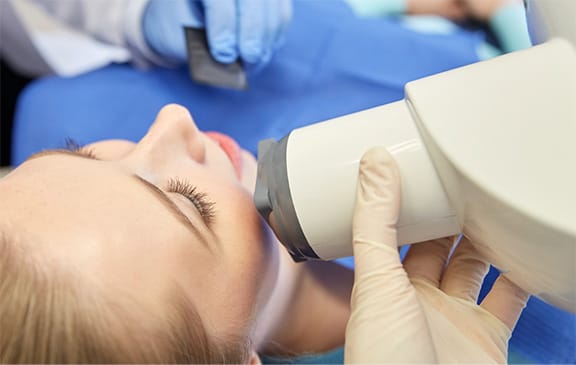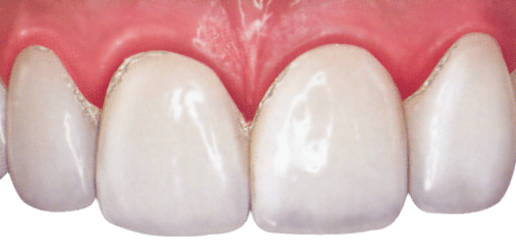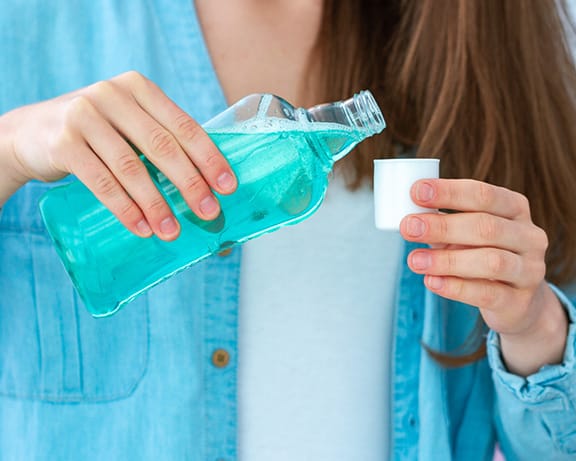Preventive

Oral Exam
New patients receive a comprehensive examination which includes a thorough check of all your teeth and gums and a screening for oral cancer, gum and bone disease, and systemic disorders. A routine oral exam is performed at least once a year on established patients at your cleaning appointments to determine any changes in dental and health status since the previous visit.
Dental x-rays are taken to evaluate your teeth, bone, and gums. At your first visit we will take a full set of 18 pictures with our digital x-ray system. Annually, we take the x-rays of your back teeth (bitewings) to check for any new decay, build up of tarter, or changes in the bone. We check all surfaces of the teeth and current restorations for any sign of decay or cavities.
In order to check for gum disease, your gums are measured with a fine instrument ruler to check the depth of the gum pocket (the space between the tooth and the connective gum tissue around the tooth.) Pocket depths more than 4 millimeters could indicate the start of gum disease and infection. The deeper the pocket, the more plaque and bacteria collects in the gums and then gum disease develops.

Plaque
Plaque is a build-up of bacteria in the mouth and particles from the foods you eat every day and forms a film around your teeth. The bacteria in the plaque consume the sugars in our foods and secrete an acid that can dissolve the teeth. If regular oral care is not practiced daily, the acid from the bacteria will start eating at the teeth producing cavities and can cause gum disease. That is why it is so important to brush and floss your teeth everyday to remove the build up of plaque.
Dental Sealants
Dental Sealants are one of the easiest preventive dental procedures that can be done. Sealing your teeth can be done in a single dental visit and is entirely painless!
Dental sealant material is a resin-like material that is applied to the tooth's chewing services and into the grooves of the tooth. The sealant will sink deep into the nooks and crannies in the chewing surface and bond directly to the enamel layer of the tooth. This seals and protects the tooth from bacteria that can cause cavities.
Brushing
Step 1 - Place bristles along the gum line at a 45 degree angle. Gently brush using a circular motion along the outer and inner tooth surfaces.
Step 2 - Brush each tooth individually. Tilt brush vertically behind the front teeth. Using the front half of the brush, use the same circular motion.
Step 3 - Place the brush against the biting surface of the teeth and use a gentle back-and-forth motion. Brush the tongue to remove odor-producing bacteria.
Flossing
Flossing removes bits of food and any plaque build-up that is caught or stuck in the tight spaces between teeth and just below the gumline where a toothbrush cannot easily reach. Proper daily flossing combined with regular brushing is one of the easiest things you can do to prevent cavities and gum disease.
Floss is cheap, so don't be stingy. Wind about 18 inches of floss evenly around each of your middle fingers until one to two inches of floss is left between the two finders. Using your thumbs and index fingers, firmly grip the floss and slide the floss between your teeth. Curve the floss around the base of your tooth while using a gentle up-and-down motion, remove food particles and any plaque build-up between the two teeth. Take special note to make sure the floss reaches just below the gumline to ensure proper and thorough cleaning.

Fluoride
Fluoride, a substance that is found naturally in water, plays an important role in healthy tooth development and cavity prevention. Fluoride combats tooth decay in two ways:
- It strengthens tooth enamel so that it can better resist the acid formed by plaque.
- Fluoride allows teeth damaged by acid to repair, or re-mineralize, themselves.
Fluoride cannot repair cavities, but it can reverse low levels of tooth decay and also prevent new cavities from forming.
Most people get the right amount of fluoride through a combination of fluoridated toothpaste and fluoridated water or supplements. However, if you have a higher risk of developing cavities, we may suggest a fluoride supplement like a rinse or prescription toothpaste.